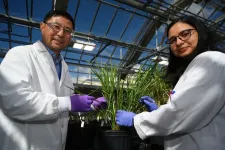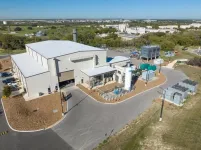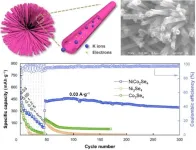(Press-News.org) UPTON, NY—Plant biologists at the U.S. Department of Energy’s (DOE) Brookhaven National Laboratory have engineered enzymes to modify grass plants so their biomass can be more efficiently converted into biofuels and other bioproducts. As described in a paper just published in Plant Biotechnology Journal, these enzymes modify molecules that make up plant cell walls to provide access to fuel-generating sugars normally locked within complex structures.
“The concept of biomass to biofuel seems simple, but it is technically very difficult to release the sugars,” noted Chang-Jun Liu, a senior plant biologist at Brookhaven Lab who led the study.
Plant biomass is full of energy-rich complex sugar molecules generated from photosynthesis. Each plant cell is surrounded by a rigid cell wall made of sugars and a material called lignin that provides structural support. Reducing lignin to gain access to the sugars has been the focus of research aimed at using plants to generate fuels and other products commonly made from petroleum.
For nearly 15 years, Liu has been tackling this problem using engineered enzymes called monolignol 4-O-methyltransferases (MOMTs). These enzymes, which do not exist in nature, are designed to alter the chemical structure of monolignols—the main building blocks of lignin. Changing the structure of the building blocks prevents them from linking together, which reduces the lignin content of plants and makes the sugars more accessible.
In prior work, Liu and his colleagues successfully expressed MOMTs in poplar trees. These enzymes reduced the trees’ lignin content and enabled more abundant sugar release from the plants. In the new research, they tested the potential applications of the MOMT enzymes in grass plants, which have an abundant biomass yield. Grasses can also grow in harsh environments, such as on soils deficient in water or nutrients. Cultivating engineered plants in such environments could potentially produce large amounts of biomass optimized for conversion to fuel and bioproducts—without competing for land needed to produce food crops.
“However, grass plant cell walls, like those from the rice plants that we studied, are even more complicated in terms of structure and composition,” explained Nidhi Dwivedi, Brookhaven Lab research associate and lead author on the new paper. In addition to sugar and lignin, grass plant cell walls also contain additional phenolic compounds that “cross-link” the cell wall components, making them even stronger and harder to break down.
“The complexity of grass plant cell walls made us curious as to whether our enzymes would improve sugar recovery,” noted Liu. “We wanted to know if MOMTs could modify the grass cell walls in a way that would provide access to the biomass.”
Less Lignin, More Sugars
Liu and Dwivedi chose to focus on two versions of the enzyme for this study—MOMT4 and MOMT9—each of which were designed to modify a different lignin subunit.
Working with collaborators from Kyoto University in Japan, Liu’s team conducted chemical analyses on rice plants engineered to express either MOMT4 or MOMT9. These studies showed there was less lignin in the modified grass plants compared to unaltered plants. Collaborators from Appalachian State University in North Carolina examined sections of the modified plant stems using scanning electron microscopy and observed changes that were consistent with the chemical analyses.
“Throughout the stem, the cell walls appeared thinner,” said Dwivedi. “And in some cells the walls even looked deformed or buckled.”
With less lignin in the cell walls, the scientists were able to collect up to 30% more sugar from plants expressing MOMT4 and up to 15% more sugar in plants expressing MOMT9, compared to unaltered plants. Through a process called fermentation, this sugar can be converted into biofuels like ethanol, which is a common additive used to lower the fossil fuel content of gasoline.
Surprisingly Promiscuous Enzymes
Enzymes—molecules that generally facilitate chemical reactions—commonly target just one type of molecule. MOMT4 and MOMT9 were designed to act upon monolignols. But when Liu and his colleagues ran tests on these enzymes, the results revealed that these engineered enzymes exhibited “promiscuity.” In addition to acting on the monolignols, both MOMTs acted on other cell wall components—the cross-linking phenolics and also a phenolic called tricin, which is a lignin precursor unique to grass plants.
When these enzymes were expressed in rice plants, they made the expected structural changes to the traditional lignin building blocks, and thus reduced the plants’ overall lignin content. But by changing the structures of the cross-linking phenolics and tricin, the MOMTs also reduced the incorporation of those compounds into the cell walls further weakening them. The scientists also found an accumulation of modified phenolics in the rest of the plant tissue that was not present in unaltered plants.
“This was quite a difference from what we saw when we expressed the same enzymes in poplar trees,” noted Liu. “The broader effects of expressing the enzymes really surprised us. Overall, the changes were positive in terms of optimizing sugar yield from grass cell walls. But there were also some unintended effects.”
For example, plants expressing MOMT9 did not grow as tall as the unaltered plants, reducing the quantity of biomass from which sugar could be accessed. The plants also failed to produce seeds, which would be a problem if the scientists want the modified plants to reproduce as a sustainable source of biofuel sugars.
To address these challenges, the scientists plan to explore methods for controlling how lignin gets modified in different parts of the plant. For example, if the scientists can reduce lignin levels everywhere in the plant other than the reproductive organs, they could maximize the ability to extract sugars without affecting the fertility of the plants.
The scientists also want to see if their MOMT enzymes can optimize sugar yields from other grass plant species.
“After seeing the effectiveness of this enzyme technology in rice, we are confident that it can be used to modify other grass energy crops like sorghum and bamboo,” Liu said.
“Biofuels are a promising alternative to non-renewable energy sources,” Dwivedi added, “This study provides insights into how scientists can optimize the release of sugar that is present in cell walls, thus overcoming some of the waste that occurs with unmodified biomass crops.”
This work was primarily funded by the DOE Office of Science.
Brookhaven National Laboratory is supported by the Office of Science of the U.S. Department of Energy. The Office of Science is the single largest supporter of basic research in the physical sciences in the United States and is working to address some of the most pressing challenges of our time. For more information, visit science.energy.gov.
Follow @BrookhavenLab on social media. Find us on Instagram, LinkedIn, Twitter, and Facebook.
END
Unlocking sugar to generate biofuels and bioproducts
Engineered enzymes could generate biomass optimized for conversion into fuel and other useful products.
2023-10-27
ELSE PRESS RELEASES FROM THIS DATE:
Evolutionary chance made this bat a specialist hunter
2023-10-27
Ask a biologist why predators don't exterminate all their prey, part of the answer often is that there is an ongoing arms race between predators and prey, with both parties continuously evolving new ways to cheat each other.
The hypothesis is particularly prevalent for bats and their prey; insects. 50 million years ago, the first bats evolved the ability to echolocate and thus hunt in the dark, and in response to this, some insects evolved ultrasound-sensitive ears so they could hear and evade the bats.
But if there is an ongoing arms race, bats should have responded to this, says University of Southern Denmark biologist, associate professor and bat ...
Intermittent fasting is safe, effective for those with Type 2 diabetes
2023-10-27
Time-restricted eating, also known as intermittent fasting, can help people with Type 2 diabetes lose weight and control their blood sugar levels, according to a new study published in JAMA Network Open from researchers at the University of Illinois Chicago.
Participants who ate only during an eight-hour window between noon and 8 p.m. each day actually lost more weight over six months than participants who were instructed to reduce their calorie intake by 25%. Both groups had similar reductions in long-term blood sugar levels, as measured by a test of hemoglobin A1C, which shows blood sugar levels over the past three months.
The ...
Effect of time-restricted eating on weight loss in adults with type 2 diabetes
2023-10-27
About The Study: This 6-month randomized clinical trial involving 75 adults with type 2 diabetes found that a time-restricted eating diet strategy without calorie counting was effective for weight loss and lowering of hemoglobin A1c levels compared with daily calorie counting. These findings will need to be confirmed by larger RCTs with longer follow-up.
Authors: Krista A. Varady, Ph.D., of the University of Illinois Chicago, is the corresponding author.
To access the embargoed study: Visit our For The Media website at this link https://media.jamanetwork.com/
(doi:10.1001/jamanetworkopen.2023.39337)
Editor’s Note: Please see the article ...
Medication abortion safety and effectiveness with misoprostol alone
2023-10-27
About The Study: The findings in this study of 637 callers to safe abortion hotlines and accompaniment groups in Argentina, Nigeria, and Southeast Asia suggest that misoprostol alone is a highly effective method of pregnancy termination. Future research should explore strategies to maximize the effectiveness of misoprostol alone in clinical and nonclinical settings.
Authors: Ruvani Jayaweera, Ph.D., of Ibis Reproductive Health in Oakland, California, is the corresponding author.
To access the embargoed study: Visit our For The Media website at this link https://media.jamanetwork.com/
(doi:10.1001/jamanetworkopen.2023.40042)
Editor’s Note: Please ...
SwRI, GTI Energy, GE celebrate mechanical completion of $155 million supercritical CO2 pilot plant
2023-10-27
SAN ANTONIO — October 27,2023 —Southwest Research Institute (SwRI®), GTI Energy, GE Vernova (GE) and the U.S. Department of Energy celebrated the ribbon-cutting of the Supercritical Transformational Electric Power (STEP) Demo pilot plant today. The $155 million, 10-megawatt supercritical carbon dioxide (sCO2) test facility at SwRI’s headquarters in San Antonio will demonstrate an innovative new method of higher-efficiency, lower-cost electric power generation.
“STEP will undoubtedly change the way we think about ...
Innovative research aims to improve wound healing and cancer therapy
2023-10-27
Jun.-Prof. Dr. Priscilla Briquez, junior professor at the Department of General and Visceral Surgery at the Freiburg University Medical Center and member of the Medical Faculty at the University of Freiburg, has received a European Research Council (ERC) Starting Grant from the European Commission. Her DRESSCODE project will receive a total of 1.5 million euros funding for five years. The project focuses on modifying proteins and developing new disease therapies.
“This support is a major opportunity for me to put together my own team and drive forward my research,” says Briquez. The focus ...
Action plan for better data on migration and health
2023-10-27
Despite rising global mobility, the state of migrant and refugee health data in European health systems is a concern, a new study shows. The analysis by an international coalition of universities, UN organizations, government representatives, and European institutions published in the journal The Lancet Regional Health Europe reveals that coverage of migrant and refugee data remains inconsistent and of suboptimal quality. According to the study this issue is not due to a lack of knowledge or technological resources ...
FDA approves muscular dystrophy drug built on Children’s National research
2023-10-27
WASHINGTON (October 27, 2023) – Boys with Duchenne muscular dystrophy (DMD) have a clinically proven, new treatment option with the Food and Drug Administration’s approval Thursday of vamorolone, a steroidal-type, anti-inflammatory drug developed based on research performed at Children’s National Hospital.
Created by ReveraGen BioPharma Inc., vamorolone has a molecular structure similar to traditional corticosteroids, which are currently used to treat DMD. Yet its structure was found to be chemically different enough to reduce unwanted side effects, including brittle bones and reduced stature. Nearly two decades ago, ReveraGen leaders – President and ...
Electrodes with hollow nanotubes improve performance of potassium-ion batteries
2023-10-27
Researchers who are working to find alternatives to lithium-ion batteries have turned their attention to potassium-ion batteries. Potassium is an abundant resource and the technology functions in much the same way as lithium-ion batteries, but these batteries have not been developed at a large scale because the ionic radius causes problems in energy storage and substandard electrochemical performance.
To solve this problem, researchers are considering NiCo2Se4, a bimetallic selenide, to create sphere-shaped electrodes. The spheres are constructed with NiCo2Se4 nanotubes, which improve ...
USDA grant will help MU researchers address opioid epidemic in rural Missouri
2023-10-27
COLUMBIA, Mo. -- Childhood trauma is a key risk factor for future substance use disorder, overdose, and suicide. This is particularly problematic in rural areas where children experience higher rates of adverse childhood experiences (ACEs). ACEs are commonly defined as physical and emotional abuse and neglect, sexual abuse, parental separation or divorce, intimate partner violence, and having household members with serious mental illness, substance use disorder, or a history of incarceration.
Now, a three-year, U.S. Department of Agriculture (USDA) grant awarded to the University of Missouri will help virtually train various members of the workforce — ...
LAST 30 PRESS RELEASES:
Making lighter work of calculating fluid and heat flow
Normalizing blood sugar can halve heart attack risk
Lowering blood sugar cuts heart attack risk in people with prediabetes
Study links genetic variants to risk of blinding eye disease in premature infants
Non-opioid ‘pain sponge’ therapy halts cartilage degeneration and relieves chronic pain
AI can pick up cultural values by mimicking how kids learn
China’s ecological redlines offer fast track to 30 x 30 global conservation goal
Invisible indoor threats: emerging household contaminants and their growing risks to human health
Adding antibody treatment to chemo boosts outcomes for children with rare cancer
Germline pathogenic variants among women without a history of breast cancer
Tanning beds triple melanoma risk, potentially causing broad DNA damage
Unique bond identified as key to viral infection speed
Indoor tanning makes youthful skin much older on a genetic level
Mouse model sheds new light on the causes and potential solutions to human GI problems linked to muscular dystrophy
The Journal of Nuclear Medicine ahead-of-print tip sheet: December 12, 2025
Smarter tools for peering into the microscopic world
Applications open for funding to conduct research in the Kinsey Institute archives
Global measure underestimates the severity of food insecurity
Child survivors of critical illness are missing out on timely follow up care
Risk-based vs annual breast cancer screening / the WISDOM randomized clinical trial
University of Toronto launches Electric Vehicle Innovation Ontario to accelerate advanced EV technologies and build Canada’s innovation advantage
Early relapse predicts poor outcomes in aggressive blood cancer
American College of Lifestyle Medicine applauds two CMS models aligned with lifestyle medicine practice and reimbursement
Clinical trial finds cannabis use not a barrier to quitting nicotine vaping
Supplemental nutrition assistance program policies and food insecurity
Switching immune cells to “night mode” could limit damage after a heart attack, study suggests
URI-based Global RIghts Project report spotlights continued troubling trends in worldwide inhumane treatment
Neutrophils are less aggressive at night, explaining why nighttime heart attacks cause less damage than daytime events
Menopausal hormone therapy may not pose breast cancer risk for women with BRCA mutations
Mobile health tool may improve quality of life for adolescent and young adult breast cancer survivors
[Press-News.org] Unlocking sugar to generate biofuels and bioproductsEngineered enzymes could generate biomass optimized for conversion into fuel and other useful products.







